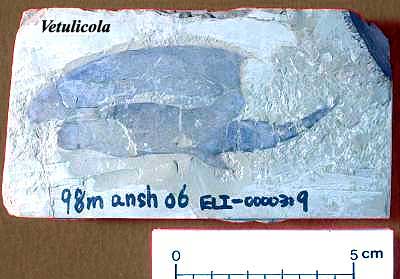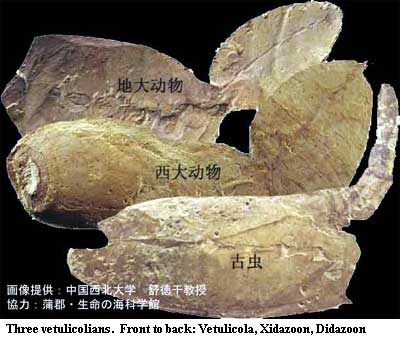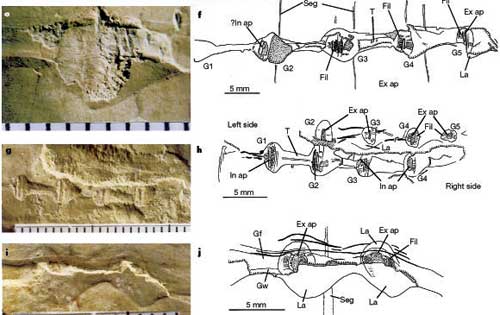|
|
Vetulicolia |
| Deuterostomia |
Vetulicolia |
Vetulicolia
 In 2001, Shu et al. suggested that a small group of Cambrian animals which they named Vetulicolia represented the stem group of modern deuterostomes. Vetulicolia possess a distinctly bipartite body plan with a voluminous anterior section bearing five pairs of lateral openings interpreted as gills) and a seven-segmented "tail". The gut runs to the posterior end of the tail. The junction between the two sections is constricted in the genera Xidazoon and Didazoon, which have an oval-shaped anterior bearing a large mouth with a strengthened rim, and a leaf-shaped tail. The genus Vetulicola has a more rectangular anterior with a "carapace" of four rigid cuticular plates. The posterior section is slender, strongly cuticularised and placed dorsally. The whole animal bears a superficial resemblance to a phyllocarid crustacean which lead to Vetulicola being originally regarded as an arthropod. However, the complete lack of appendages, the gill openings and the four-plated nature of the carapace are distinct from all known arthropods. Finally, the genus Pomatrumhas an anterior like Didazoon and Xidazoon, but a slender tail like Vetulicola.
In 2001, Shu et al. suggested that a small group of Cambrian animals which they named Vetulicolia represented the stem group of modern deuterostomes. Vetulicolia possess a distinctly bipartite body plan with a voluminous anterior section bearing five pairs of lateral openings interpreted as gills) and a seven-segmented "tail". The gut runs to the posterior end of the tail. The junction between the two sections is constricted in the genera Xidazoon and Didazoon, which have an oval-shaped anterior bearing a large mouth with a strengthened rim, and a leaf-shaped tail. The genus Vetulicola has a more rectangular anterior with a "carapace" of four rigid cuticular plates. The posterior section is slender, strongly cuticularised and placed dorsally. The whole animal bears a superficial resemblance to a phyllocarid crustacean which lead to Vetulicola being originally regarded as an arthropod. However, the complete lack of appendages, the gill openings and the four-plated nature of the carapace are distinct from all known arthropods. Finally, the genus Pomatrumhas an anterior like Didazoon and Xidazoon, but a slender tail like Vetulicola.
The position of vetulicolians relative to other deuterostomes is still contentious. Shu et al. did not identify anything resembling a notochord, which may indicate a position outside the deuterostome crown. However, they identified a dark ventral structure in the anterior part of Xidazoon and Didazoon as a possible endostyle, a structure currently known only from chordates. Vetulicolians bear a superficial resemblance to a tunicate "tadpole" larva, and also to the divided "somato-visceral" animal hypothesized by Romer as the ancestor of vertebrates. Shu et al. (2001). Lacalli (2002) suggested that the vetulicolian cuticle was  homologous to the urochordate tunic.
homologous to the urochordate tunic.
Other fossil animals may be assignable to the Vetulicolia or their near relatives. The worm-like Banffia resembles Vetulicolia in its bipartite body, as does the recently described Skeemella (Briggs et al., 2005), both from the Cambrian. Both these genera, however, have considerably more segments in the posterior section (43 in Skeemella) and no sign of gill openings. Briggs et al. argued on this basis that the assignment of vetulicolians to deuterostomes was probably unjustified. It is possible, of course, that these two genera are not related to Vetulicolia, or that they are further down on the deuterostome stem and predate the origin of gill openings.
When Xidazoon was first described as an unplaced problematicum (Shu et al., 1999) it was compared on the basis of the rim of plates around the mouth to the "agnathan" Pipiscius from the Carboniferous Mazon Creek of Illinois. Other features such as possession of gill rays would retain Pipiscius in the chordates.
Finally, the Burgess Shale problematicum Nectocaris resembles Vetulicola in its possession of an arthropod-like carapace with a chordate-like tail and no appendages.
The Yunnanozoa are another group of Cambrian animals known from the Chengjiang Lagerstatte of China. Two genera are known,  Yunnanozoonand Haikouella. Like vetulicolians, they have a bipartite body plan with a gill-bearing (six pairs) anterior and a segmented posterior. Unlike vetulicolians, the segmented section overlays the slender canoe-shaped anterior to a significant degree. The two sections are connected by a median zone which apparently had a thinner cuticle, probably allowing the anterior region to expand and contract in height. The gills were external and an outwardly- and downwardly-directed "skirt" surrounded the anterior section. Yunnanozoans have generally been regarded as chordates, and Dzik (1995) identified structures on the head of Yunnanozoon with a notochord running ventrally to the "muscle blocks" (the posterior segments). These structures were not identified in Haikouella by Shu et al. (2003), and Dzik's "eyes" probably correspond to the front of the skirt around the anterior. Other authors identify both a dorsal and a ventral nerve cord, which might support a position closer to hemichordates.
Yunnanozoonand Haikouella. Like vetulicolians, they have a bipartite body plan with a gill-bearing (six pairs) anterior and a segmented posterior. Unlike vetulicolians, the segmented section overlays the slender canoe-shaped anterior to a significant degree. The two sections are connected by a median zone which apparently had a thinner cuticle, probably allowing the anterior region to expand and contract in height. The gills were external and an outwardly- and downwardly-directed "skirt" surrounded the anterior section. Yunnanozoans have generally been regarded as chordates, and Dzik (1995) identified structures on the head of Yunnanozoon with a notochord running ventrally to the "muscle blocks" (the posterior segments). These structures were not identified in Haikouella by Shu et al. (2003), and Dzik's "eyes" probably correspond to the front of the skirt around the anterior. Other authors identify both a dorsal and a ventral nerve cord, which might support a position closer to hemichordates.
Images: Vetulicola from 岐阜大学教育学部 理科教育講座地学教室(Gifu University Department of Education Science Education. Geography Classroom). Three vetulicolians from the Internet Museum of Natural History. Vetulicola gill structures from Shu et al. (2001).
page uploaded ATW050823
 In 2001, Shu et al. suggested that a small group of Cambrian animals which they named Vetulicolia represented the stem group of modern deuterostomes. Vetulicolia possess a distinctly bipartite body plan with a voluminous anterior section bearing five pairs of lateral openings interpreted as gills) and a seven-segmented "tail". The gut runs to the posterior end of the tail. The junction between the two sections is constricted in the genera Xidazoon and Didazoon, which have an oval-shaped anterior bearing a large mouth with a strengthened rim, and a leaf-shaped tail. The genus Vetulicola has a more rectangular anterior with a "carapace" of four rigid cuticular plates. The posterior section is slender, strongly cuticularised and placed dorsally. The whole animal bears a superficial resemblance to a phyllocarid crustacean which lead to Vetulicola being originally regarded as an arthropod. However, the complete lack of appendages, the gill openings and the four-plated nature of the carapace are distinct from all known arthropods. Finally, the genus Pomatrumhas an anterior like Didazoon and Xidazoon, but a slender tail like Vetulicola.
In 2001, Shu et al. suggested that a small group of Cambrian animals which they named Vetulicolia represented the stem group of modern deuterostomes. Vetulicolia possess a distinctly bipartite body plan with a voluminous anterior section bearing five pairs of lateral openings interpreted as gills) and a seven-segmented "tail". The gut runs to the posterior end of the tail. The junction between the two sections is constricted in the genera Xidazoon and Didazoon, which have an oval-shaped anterior bearing a large mouth with a strengthened rim, and a leaf-shaped tail. The genus Vetulicola has a more rectangular anterior with a "carapace" of four rigid cuticular plates. The posterior section is slender, strongly cuticularised and placed dorsally. The whole animal bears a superficial resemblance to a phyllocarid crustacean which lead to Vetulicola being originally regarded as an arthropod. However, the complete lack of appendages, the gill openings and the four-plated nature of the carapace are distinct from all known arthropods. Finally, the genus Pomatrumhas an anterior like Didazoon and Xidazoon, but a slender tail like Vetulicola.
